A Personalized Learning Service Compatible with Moodle E-Learning Management System
Abstract
1. Introduction
2. Related Works
2.1. Learning Management Platforms
- Moodle is a convenient platform for instructors to develop e-learning resources and teaching interaction;
- Users can expand and module for functions and services;
- The functionality of Moodle is relatively complete compared with that of other learning management platforms.
2.2. Personalized Learning
3. Personalized Service (Methods)
- Administrator
- Personalized learning map service: uses graphic visualization to realize a personalized learning map, allowing administrators to maintain personal learning requirements and characteristics. By using the course service of the management platform learners, administrators set required subjects for learners.
- SIMS synchronization service: imports the third-party user management platform system (such as the human resource management system used by the industry or the school’s educational administration registered student management system) into Moodle. By synchronizing the user identity with authority to use the service in Moodle, the administrator and the instructor can list and print the learner information for a specific Moodle course in a report format.
- Instructor
- Learner Portfolio service: combines with Beacon indoor positioning technology; the teacher sets the list of students taking the course. When the students enter the designated space or classroom, they use a handheld device to perform a roll call. The proposed service collects the learners’ learning history and provides reports to manage and create a teaching environment.
- Learning feedback service: teachers can use the learning feedback service to understand the learners’ learning conditions and ideas after the students complete a course. The system’s fine-tuning is necessary to refine the course materials and procedures continually.
- Learner
- Personalized learning map service: obtains a personalized learning map that matches learning demand according to individual needs and characteristics. The system automatically recommends personalized learning courses to reduce students’ self-loss in the boundless studies and e-materials and affect learning willingness.
- Learning feedback service: the students can use the learning feedback service to deliver the learning conditions and suggestions after the course.
- (1)
- The web management module includes core capabilities, analysis methods, medals, website location and language, security, home page, and other settings.
- (2)
- The user management module handles user-related, user rights, and privacy settings.
- (3)
- The course management module manages courses and categories, class application, and backup settings.
- (4)
- The assessment management module sets a scoring item, scale, score.
- (5)
- The plugin management module is for the plugin settings installed on the website, such as reporting, uploading, antivirus, various activity modules, and other detailed function settings.
- (6)
- The interface management module is for setting the interface and theme.
- (7)
- The server management module includes the basic settings related to the website host and e-mail.
- (8)
- The report management module views the items recorded on the website, such as backup, comments, setting changes, event list, log, performance, questionnaire, questionnaire results, and information security status.
- (9)
- The development management module is used by programmers for development, debugging, and testing functions.
- SIMS synchronized service: synchronizes the user profiles from a student information management system (SIMS), which is the essential reference for personalized learning.
- Personalized learning map service: provides personalized e-course based on SIMS user’s learning demands and characteristics.
- Learner portfolio service: provides a course enrollment and deposits learners’ learning situations.
- Learning feedback service: completed learning feedback is used to explore the impact of different teaching factors on learning effectiveness.
3.1. SIMS Synchronized Service
- Users’ portfolios import function: an administrator can upload users’ portfolios from SIMS into CSV format, significantly reducing the time of labor required in manual input confirmation and modification for comparing users’ identification.
- Users’ portfolios export function: An administrator and an instructor can output the learner portfolio as an XLS or CSV file for convenient report production for a specific course.
- Step 1.i.1.
- An administrator selects the SIMS portfolio synchronized service for the import function.
- Step 1.i.2.
- The administrator converts the SIMS portfolio into CSV format and uploads the CSV file into Moodle. The user profiles comparison contains three situations:
- (1)
- If a user profile exists in Moodle but not in the SIMS database, Moodle deletes the user profile.
- (2)
- If a user profile exists in Moodle and exists in the third-party database, Moodle updates the user profile according to the information in the SIMS database.
- (3)
- If a user profile does not exist in Moodle but exists in the SIMS database, Moodle adds the user profile according to the information in the SIMS database.
- Step 1.i.3.
- Moodle synchronizes the users’ identities and usage rights and lists the synchronized results for the administrator.
- Step 1.ii.1.
- An administrator selects the users’ portfolios export function of SIMS synchronized service for the export function.
- Step 1.ii.2.
- The administrator inquiries about users’ profiles for a course in Moodle.
- Step 1.ii.3.
- Moodle converts the inquired results into XLS/CSV format for the administrator to download the XLS/CSV file.
3.2. Personalized Learning Map Service
- Step 2.1.
- An administrator selects setting the personalized learning map service.
- Step 2.2.
- The service analyzes the personalized demand according to the portfolio imported from SIMS.
- Step 2.3.
- Step 2.4.
- The computed result recommends the personalized e-materials and courses corresponding to the learner’s demand.
3.3. Learner Portfolio Service
- Step 3.1.
- After an instructor used the Beacon sign-in service interface to confirm the course enrollment list, the service would automatically generate the sign-in form.
- Step 3.2.
- When a learner entered the classroom, the service received the Beacon information. The service searched and confirmed the list of course sign-up.
- Step 3.3.
- The system deposited and collected the sign-in data and recorded it in the report for the course enrollment list. The instructor could make it into a sign-in form for printing it out directly.
3.4. Learning Feedback Service
- Step 4.1.
- The instructor sets up the questionnaire according to the course and reserves it to the course repository.
- Step 4.2.
- After completing the course, the learner fills in the course questionnaire, and the system records it in the report repository.
- Step 4.3.
- The instructor can inquire about the course questionnaire results from the report repository and output them to XLS format for subsequent analysis.
4. Experiment Design
4.1. System Information
4.2. Experiment Procedure
- Step 1.
- Programming requirement learning: In classroom environments, an instructor taught programming syntax to establish basic training in programming. Supplemented code examples helped the students learn and understand programming grammar.
- Step 2.
- Mid-term assessment: The mid-term assessment test contained a comprehension test and a programming test to understand the students’ learning status in the first eight weeks to carry out the next stage of personalized learning.
- Step 3.
- Personalized Learning: According to the Mid-term results, students had individual learning on the Moodle e-learning platform with the personalized service provided in this study, allowing students to enhance or remediate learning based on the assessment results.
- Step 4.
- Final assessment: This experiment conducted a final exam at 18 weeks as a post-test score.
- Step 5.
- Feedback: The learning feedback service was used to understand the learning status and reflections.
4.3. Results
5. Discussion
6. Conclusions and Future Developments
Author Contributions
Funding
Institutional Review Board Statement
Informed Consent Statement
Data Availability Statement
Conflicts of Interest
References
- Sangrà, A.; Vlachopoulos, D.; Cabrera, N. Building an inclusive definition of e-learning: An approach to the conceptual framework. Int. Rev. Res. Open Distrib. Learn. 2012, 13, 145–159. [Google Scholar] [CrossRef]
- Liu, S.; Guo, C.; Al-Turjman, F.; Muhammad, K.; de Albuquerque, V.H.C. Reliability of response region: A novel mechanism in visual tracking by edge computing for IIoT environments. Mech. Syst. Signal Process. 2020, 138, 106537. [Google Scholar] [CrossRef]
- Liu, S.; Wang, S.; Liu, X.; Lin, C.-T.; Lv, Z. Fuzzy detection aided real-time and robust visual tracking under complex environments. IEEE Trans. Fuzzy Syst. 2020, 29, 90–102. [Google Scholar] [CrossRef]
- Maatuk, A.M.; Elberkawi, E.K.; Aljawarneh, S.; Rashaideh, H.; Alharbi, H. The COVID-19 pandemic and E-learning: Challenges and opportunities from the perspective of students and instructors. J. Comput. High. Educ. 2021, 34, 21–38. [Google Scholar] [CrossRef] [PubMed]
- Sinaga, R.R.F.; Pustika, R. Exploring STUDENTS’ATTITUDE towards English online learning using moodle during COVID-19 pandemic at smk yadika bandarlampung. J. Engl. Lang. Teach. Learn. 2021, 2, 8–15. [Google Scholar]
- Doanh, D.C.; Thang, H.N.; Nga, N.T.V.; Van, P.T.; Hoa, P.T. Entrepreneurial behaviour: The effects of the fear and anxiety of Covid-19 and business opportunity recognition. Entrep. Bus. Econ. Rev. 2021, 9, 7–23. [Google Scholar]
- Gao, P.; Li, J.; Liu, S. An introduction to key technology in artificial intelligence and big data driven e-learning and e-education. Mob. Netw. Appl. 2021, 26, 2123–2126. [Google Scholar] [CrossRef]
- Chen, S.Y.; Wang, J.-H. Individual differences and personalized learning: A review and appraisal. Univers. Access Inf. Soc. 2021, 20, 833–849. [Google Scholar] [CrossRef]
- Gamage, S.H.; Ayres, J.R.; Behrend, M.B. A systematic review on trends in using Moodle for teaching and learning. Int. J. STEM Educ. 2022, 9, 1–24. [Google Scholar] [CrossRef] [PubMed]
- Raleiras, M.; Nabizadeh, A.H.; Costa, F.A. Automatic learning styles prediction: A survey of the State-of-the-Art (2006–2021). J. Comput. Educ. 2022, 1–93. [Google Scholar] [CrossRef]
- Chen, C.-M. Intelligent web-based learning system with personalized learning path guidance. Comput. Educ. 2008, 51, 787–814. [Google Scholar] [CrossRef]
- Chu, C.-P.; Chang, Y.-C.; Tsai, C.-C. PC2PSO: Personalized e-course composition based on Particle Swarm Optimization. Appl. Intell. 2011, 34, 141–154. [Google Scholar] [CrossRef]
- Li, J.-W.; Chang, Y.-C.; Chu, C.-P.; Tsai, C.-C. A self-adjusting e-course generation process for personalized learning. Expert Syst. Appl. 2012, 39, 3223–3232. [Google Scholar] [CrossRef]
- Chen, C.-M.; Duh, L.-J. Personalized web-based tutoring system based on fuzzy item response theory. Expert Syst. Appl. 2008, 34, 2298–2315. [Google Scholar] [CrossRef]
- Hsieh, T.-C.; Wang, T.-I.; Su, C.-Y.; Lee, M.-C. A fuzzy logic-based personalized learning system for supporting adaptive English learning. J. Educ. Technol. Soc. 2012, 15, 273–288. [Google Scholar]
- Lin, C.F.; Yeh, Y.-C.; Hung, Y.H.; Chang, R.I. Data mining for providing a personalized learning path in creativity: An application of decision trees. Comput. Educ. 2013, 68, 199–210. [Google Scholar] [CrossRef]
- Rice, W.; William, H. Moodle; Packt Publishing: Birmingham, UK, 2006. [Google Scholar]
- Romero, C.; Ventura, S.; García, E. Data mining in course management systems: Moodle case study and tutorial. Comput. Educ. 2008, 51, 368–384. [Google Scholar] [CrossRef]
- Ikawati, Y.; Al Rasyid, M.U.H.; Winarno, I. Student behavior analysis to detect learning styles in Moodle learning management system. In Proceedings of the 2020 International Electronics Symposium (IES), Surabaya, Indonesia, 19—30 September 2020; pp. 501–506. [Google Scholar]
- Campo, M.; Amandi, A.; Biset, J.C. A software architecture perspective about Moodle flexibility for supporting empirical research of teaching theories. Educ. Inf. Technol. 2021, 26, 817–842. [Google Scholar] [CrossRef] [PubMed]
- Tarabasz, A.; Selaković, M.; Abraham, C. The classroom of the future: Disrupting the concept of contemporary business education. Entrep. Bus. Econ. Rev. 2018, 6, 231. [Google Scholar] [CrossRef]
- Jeong, H.-Y.; Choi, C.-R.; Song, Y.-J. Personalized Learning Course Planner with E-learning DSS using user profile. Expert Syst. Appl. 2012, 39, 2567–2577. [Google Scholar] [CrossRef]
- Chang, T.-Y.; Ke, Y.-R. A personalized e-course composition based on a genetic algorithm with forcing legality in an adaptive learning system. J. Netw. Comput. Appl. 2013, 36, 533–542. [Google Scholar] [CrossRef]
- Chao, S.-Y.; Chang, Y.-C.; Yang, S.; Clark, M. Development, implementation, and effects of an integrated web-based teaching model in a nursing ethics course. Nurse Educ. Today 2017, 55, 31–37. [Google Scholar] [CrossRef] [PubMed]
- Smatkov, S.; Kuchuk, N.; Sieja, M. The method of centralised distribution of electronic educational resources in academic e-learning. Tech. Trans. 2019, 2, 119–128. [Google Scholar] [CrossRef]
- Wang, J.; Xie, H.; Wang, F.L.; Lee, L.-K.; Au, O.T.S. Top-N personalized recommendation with graph neural networks in MOOCs. Comput. Educ. Artif. Intell. 2021, 2, 100010. [Google Scholar] [CrossRef]
- Benmesbah, O.; Lamia, M.; Hafidi, M. An improved constrained learning path adaptation problem based on genetic algorithm. Interact. Learn. Environ. 2021, 1–18. [Google Scholar] [CrossRef]
- Goštautaitė, D.; Kurilov, J. Comparative Analysis of Exemplar-Based Approaches for Students’ Learning Style Diagnosis Purposes. Appl. Sci. 2021, 11, 7083. [Google Scholar] [CrossRef]
- Peterka, V. Bayesian approach to system identification. In Trends and Progress in System identification. Elsevier: Amsterdam, The Netherlands, 1981; pp. 239–304. [Google Scholar]
- García, P.; Schiaffino, S.; Amandi, A. An enhanced Bayesian model to detect students’ learning styles in Web-based courses. J. Comput. Assist. Learn. 2008, 24, 305–315. [Google Scholar] [CrossRef]
- Pfanzagl, J.; Sheynin, O. Studies in the history of probability and statistics XLIV A forerunner of the t-distribution. Biometrika 1996, 83, 891–898. [Google Scholar] [CrossRef]
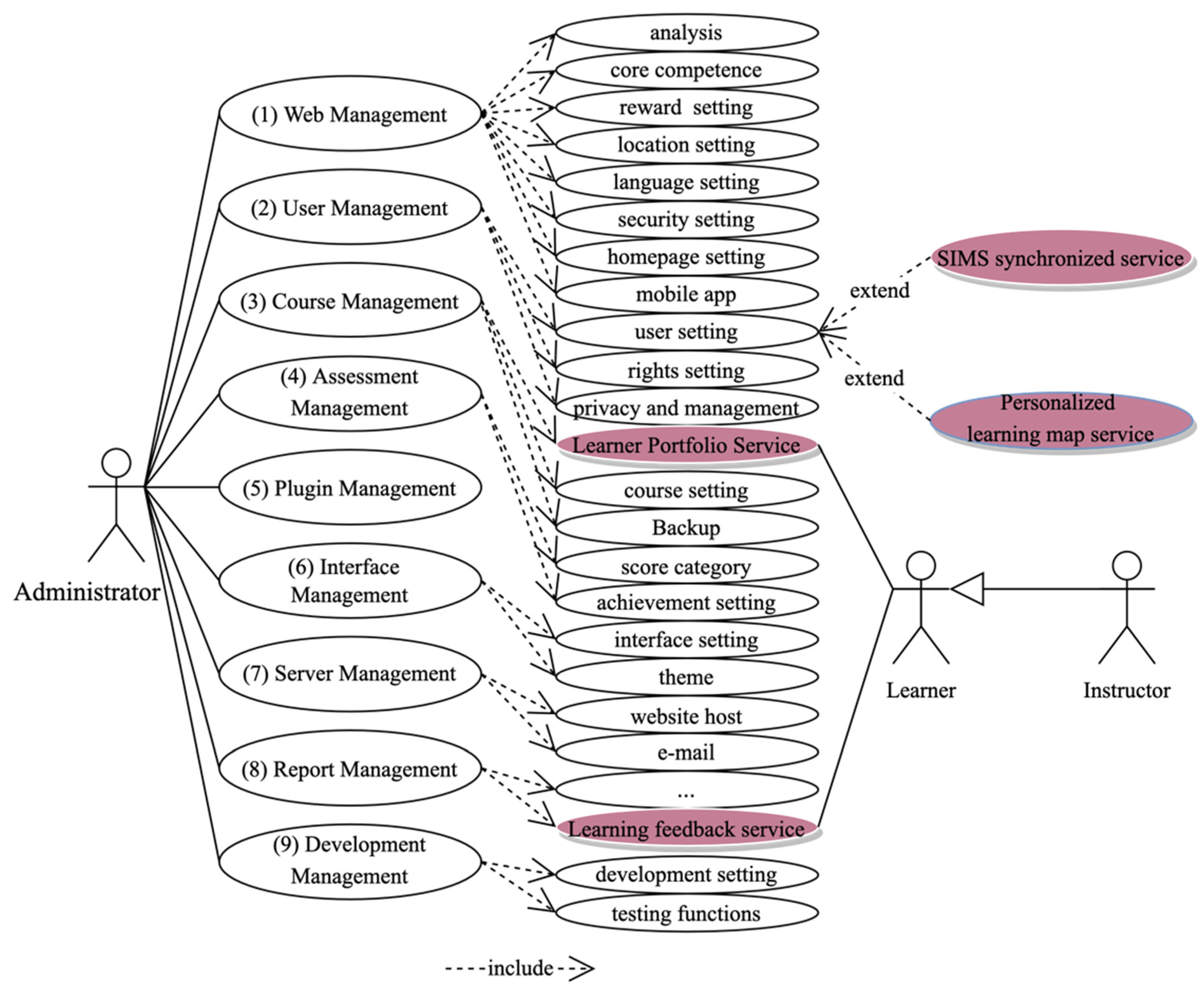
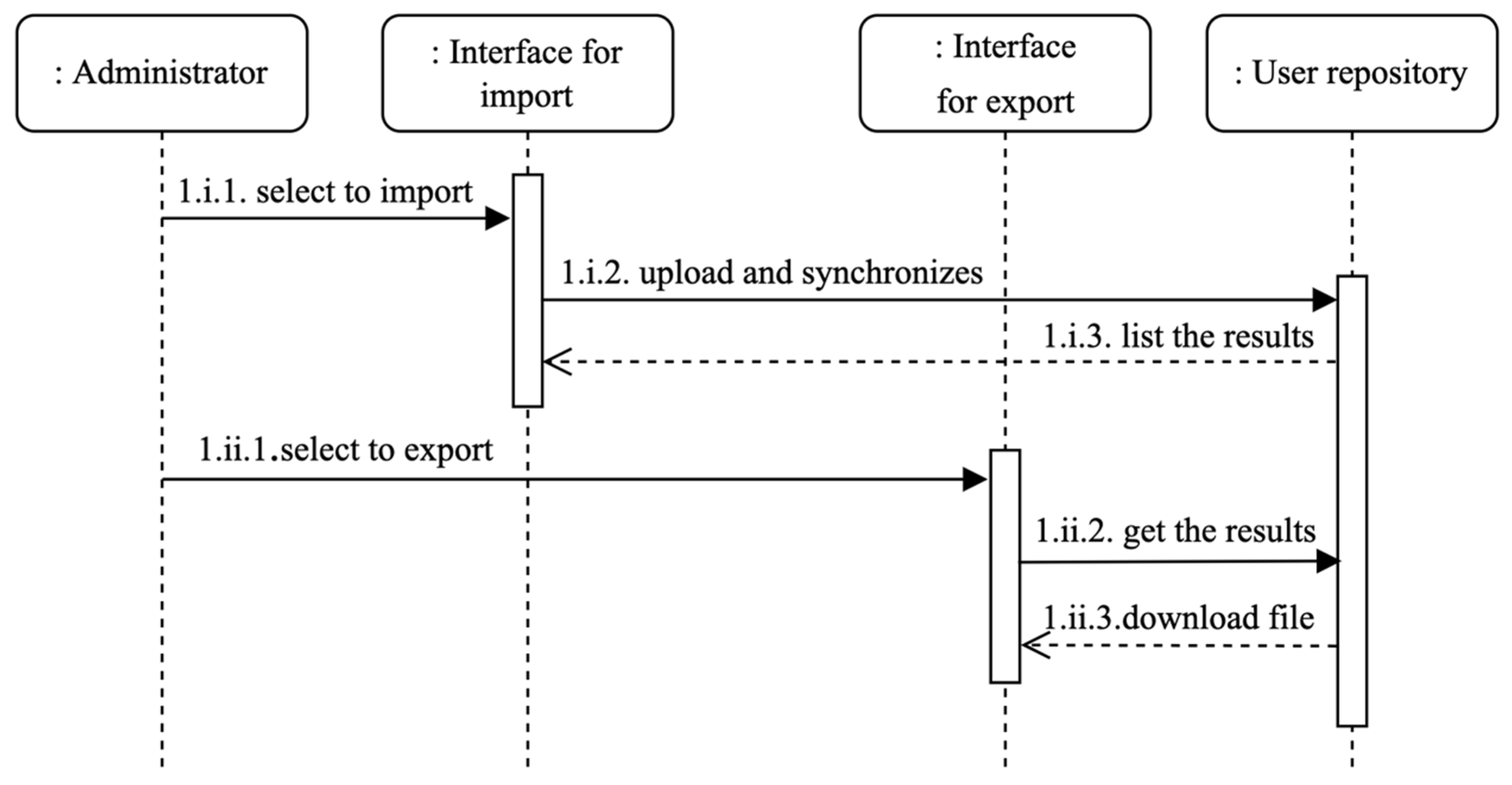
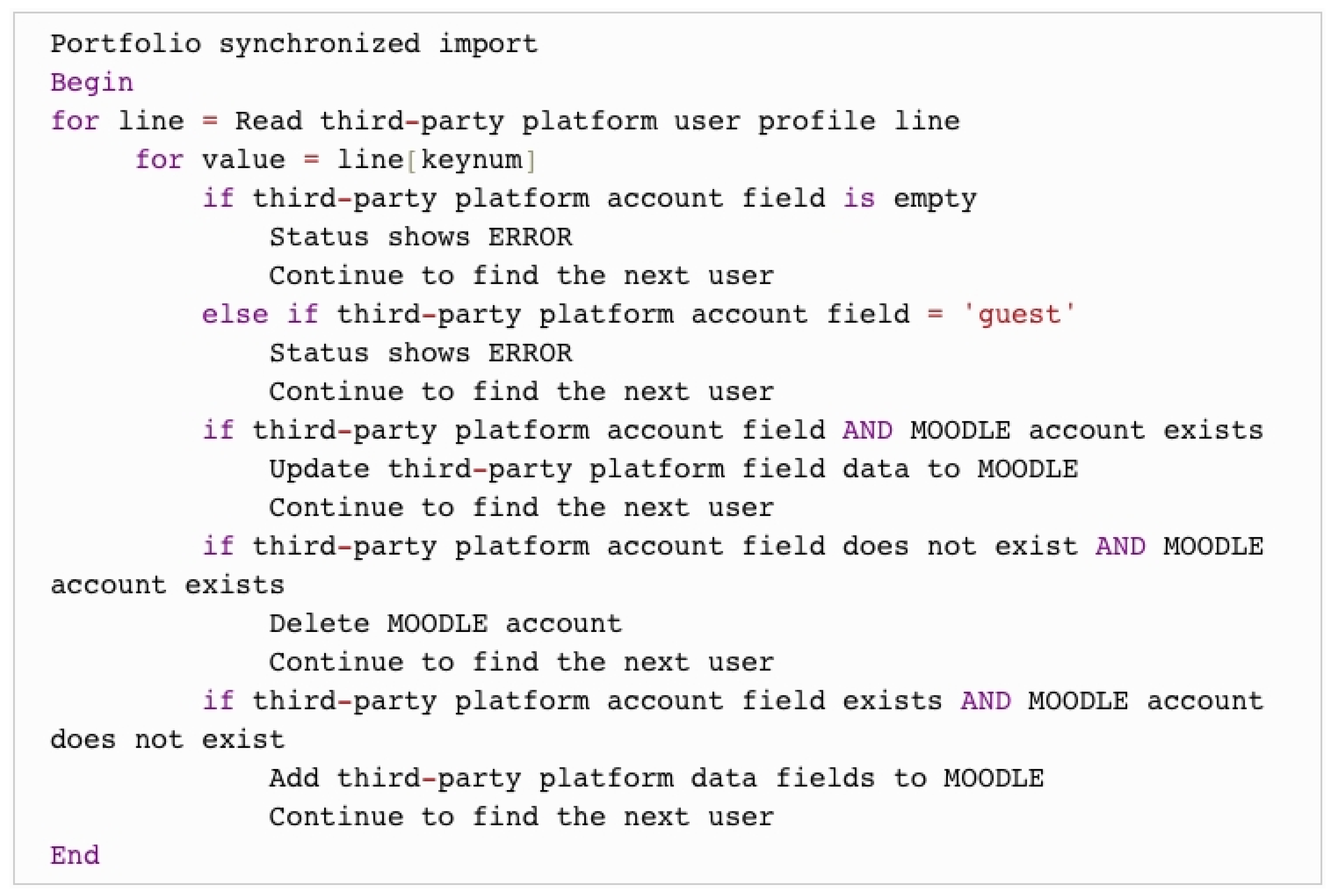
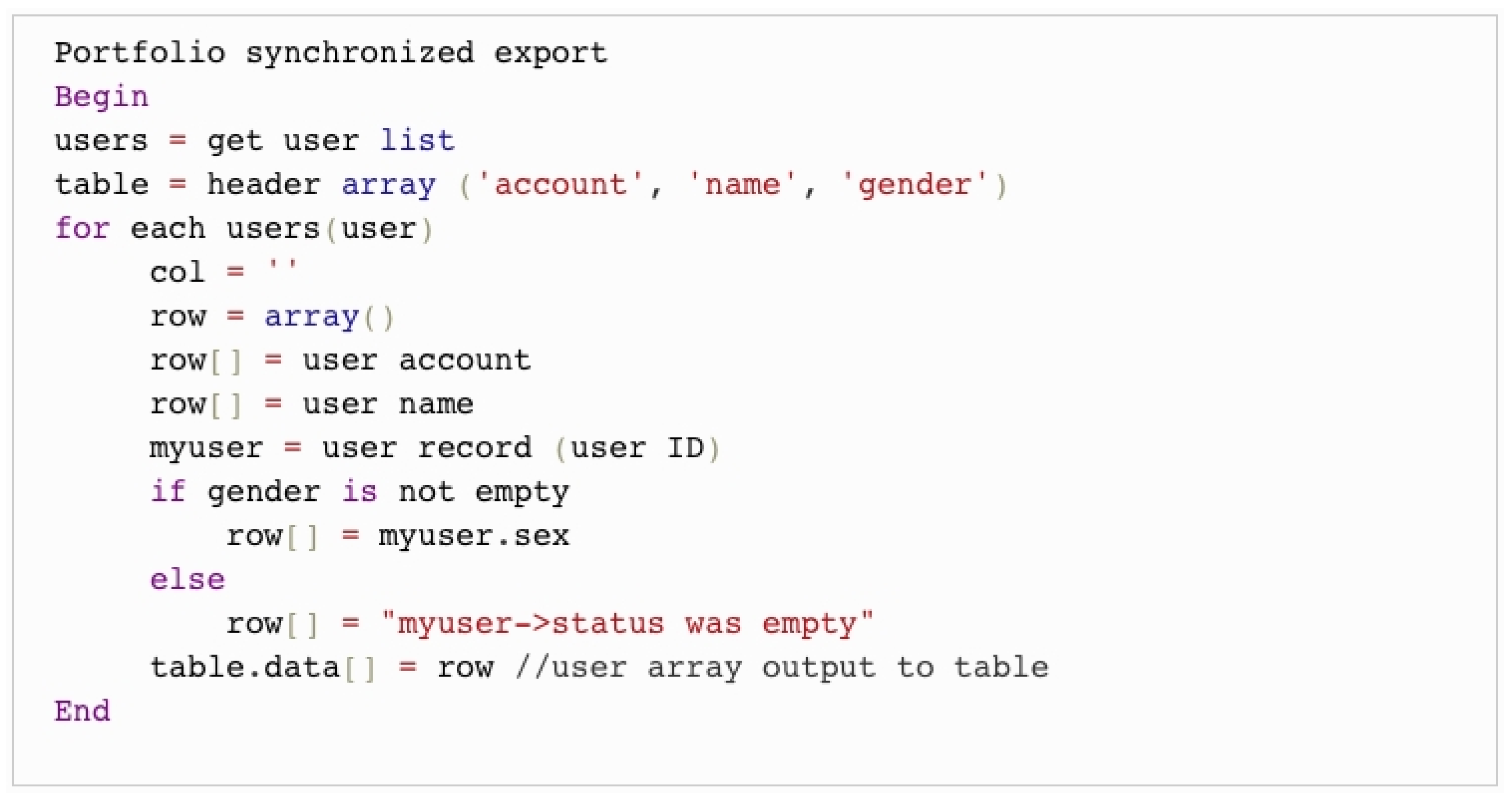
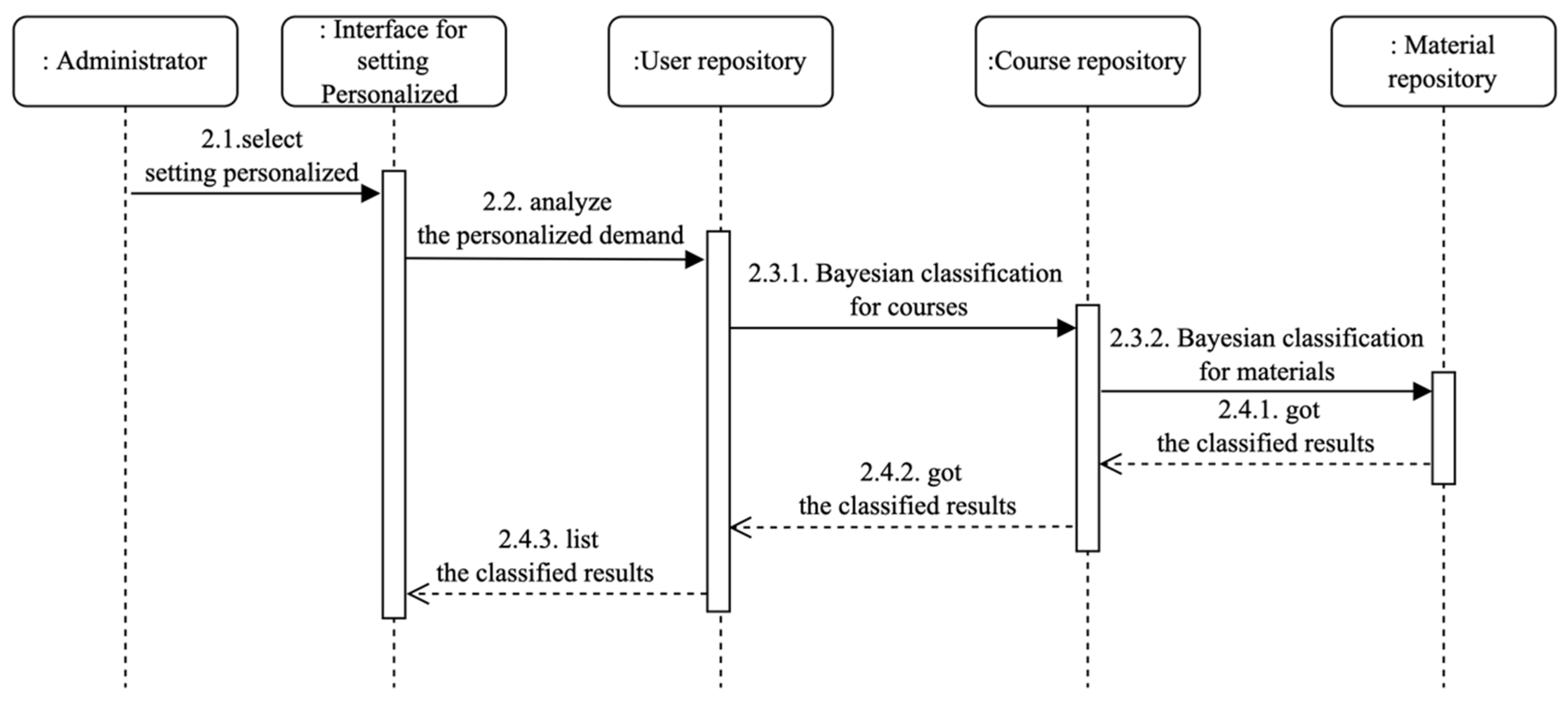
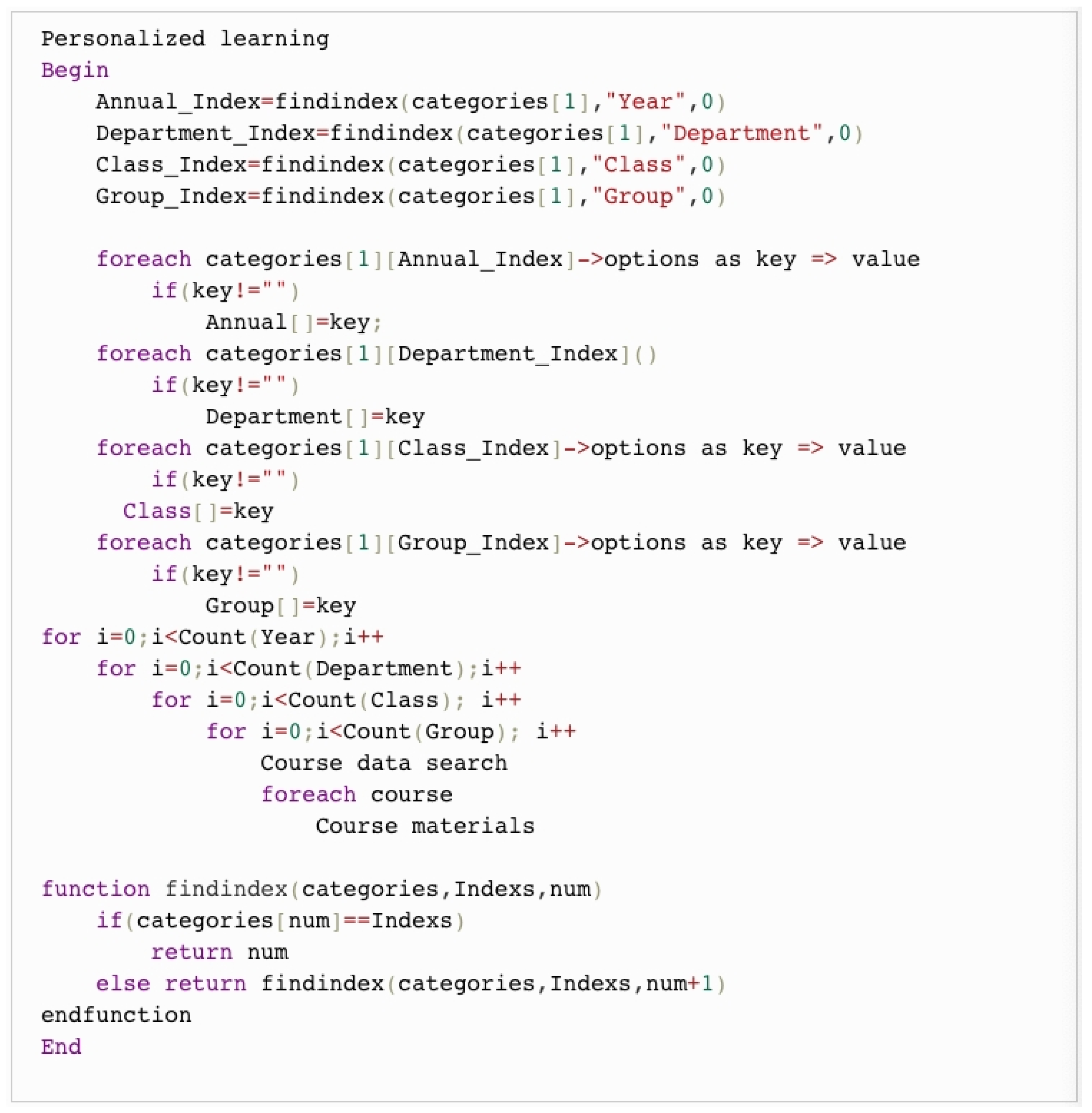
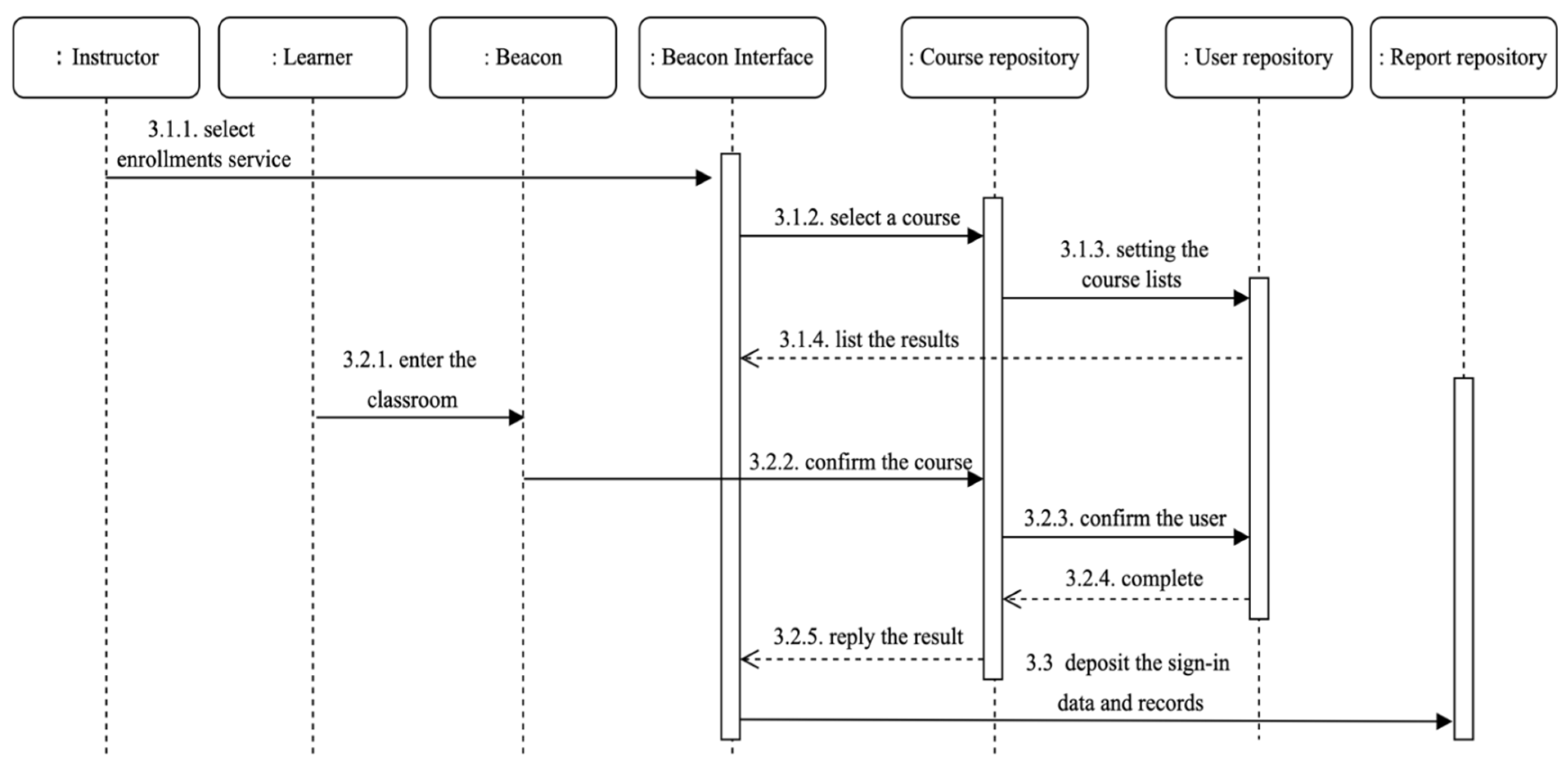
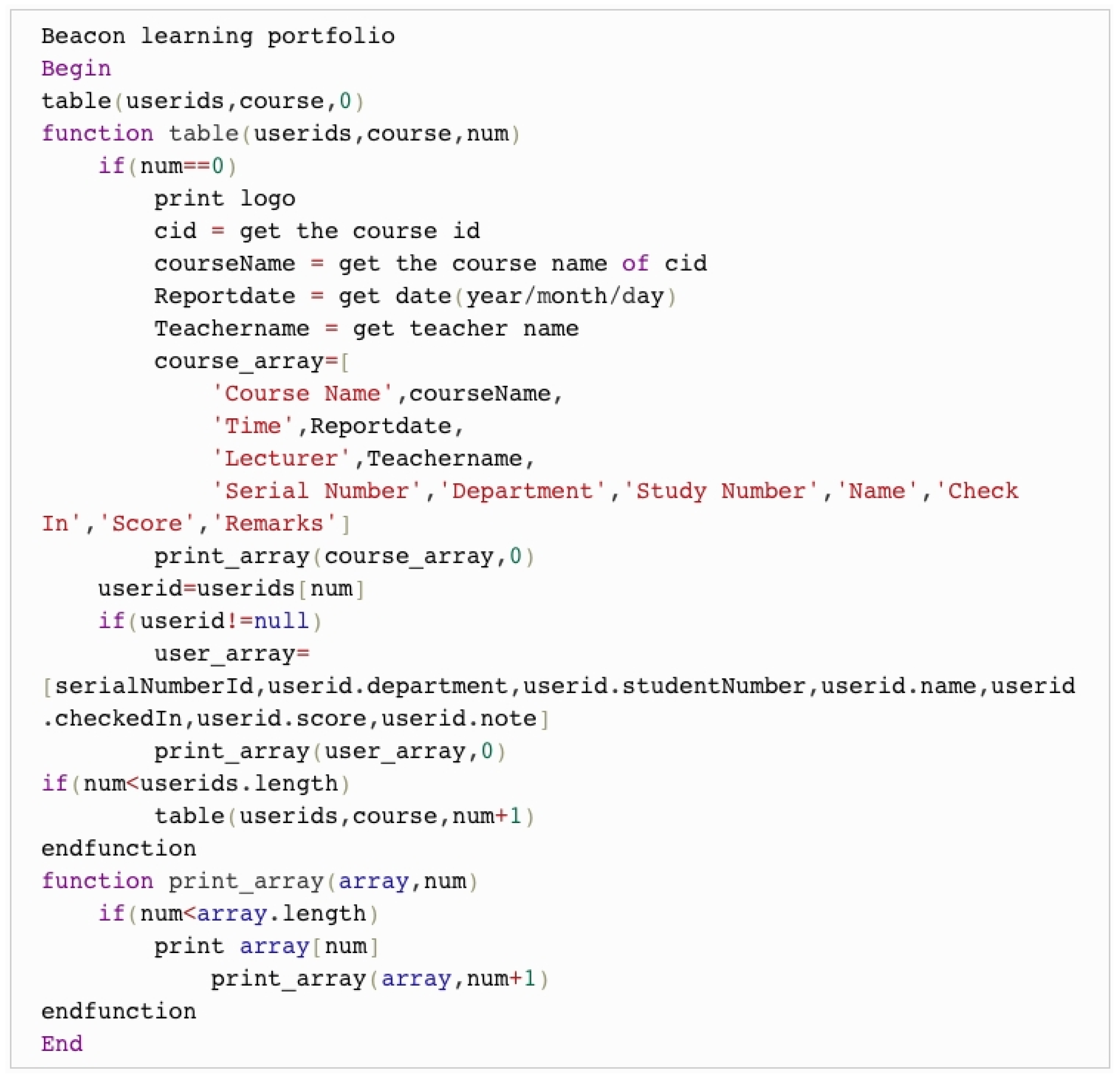

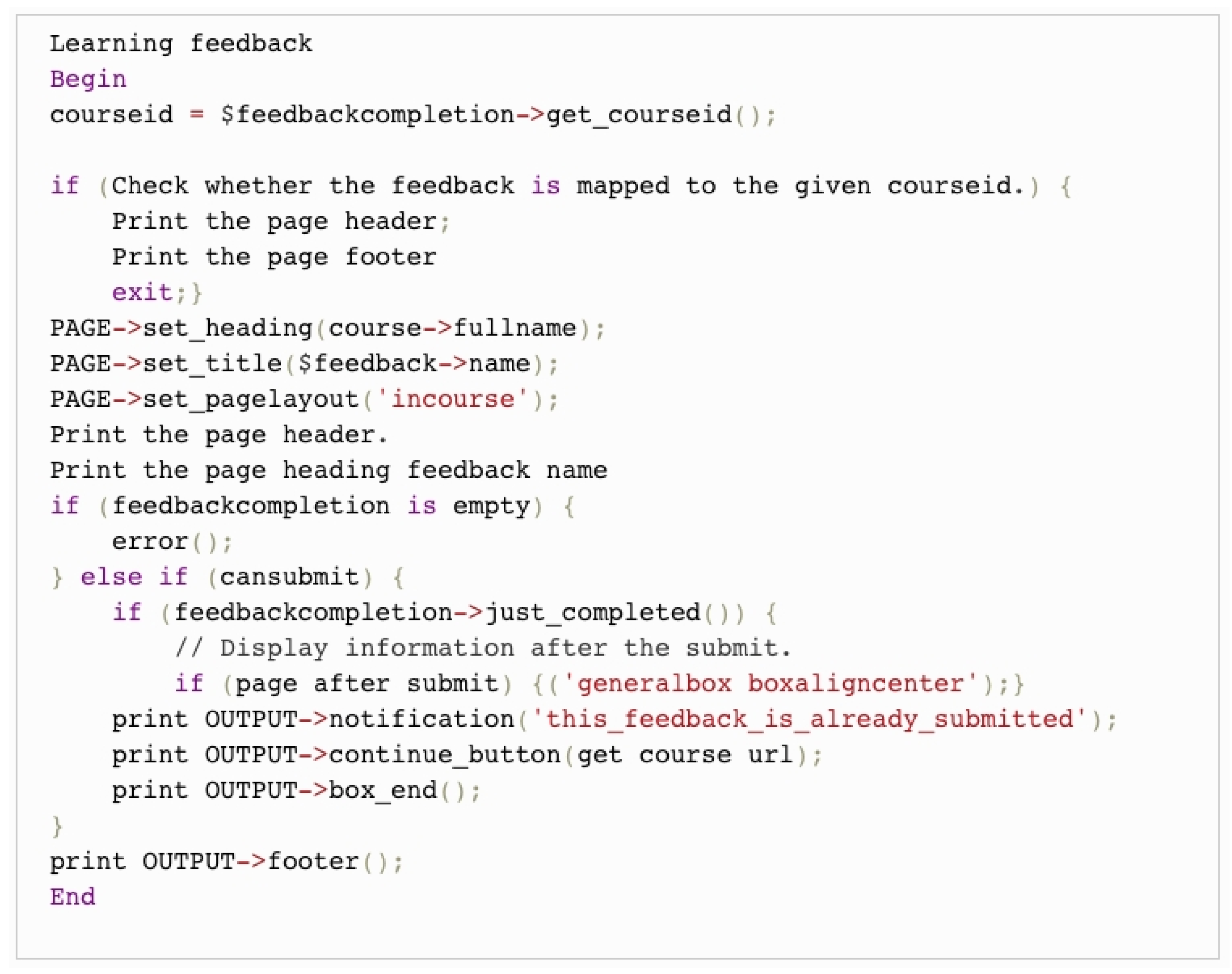
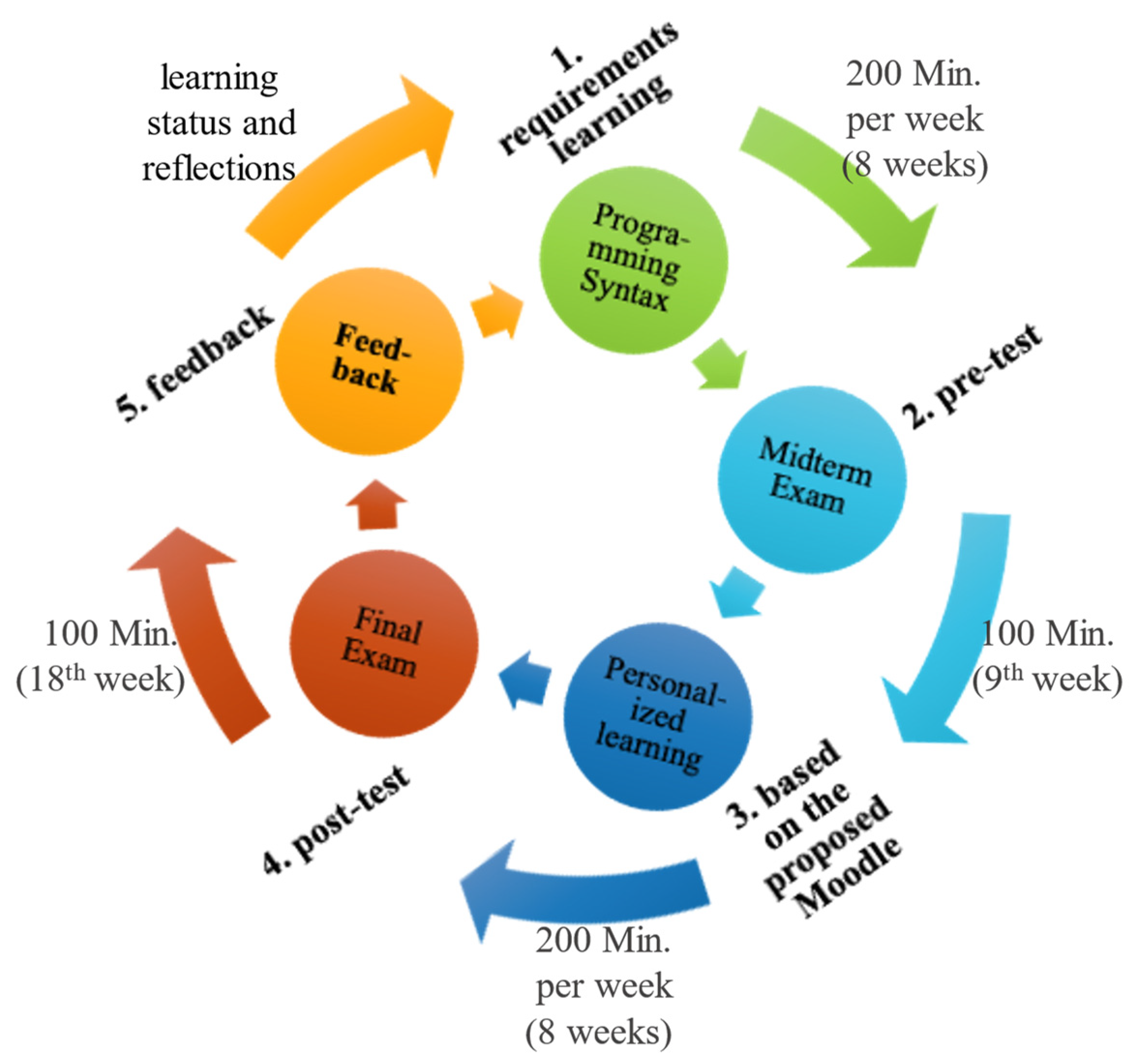
| Compared Item | Blackboard | WisdomMaster | Moodle |
|---|---|---|---|
| System Architecture | JAVA, Oracle | PHP, Mysql | PHP, Mysql |
| Supported Operating Systems | Unix “Linux” Windows | Unix “Linux” Windows | Unix “Linux” Windows |
| How to get | Need to buy | Need to buy | Available online |
| Presenting support | Web page | Web page | Web page |
| System support | Original technical support | Original technical support | Forum or self-maintained |
| System expansion | Purchased separately | Purchased separately | Modularization and Self-expandable |
| Compared Item | Blackboard | WisdomMaster | Moodle |
|---|---|---|---|
| Course content exchange | Yes | No | Yes |
| Teaching material management | Yes | Yes | Yes |
| Browse multiple courses | Yes | Yes | Yes |
| Multi-language support | Yes | No | Yes |
| Compared Item | Blackboard | WisdomMaster | Moodle |
|---|---|---|---|
| Sync discussion boards | Yes | Yes | Yes |
| Electronic Whiteboard | Yes | No | Yes |
| Asynchronous Discussion Forum | Yes | Yes | Yes |
| Curriculum Teaching Assistant | No | Yes | Yes |
| Online grouping of learners | Yes | Yes | Yes |
| Group interactive discussion area | Yes | Yes | Yes |
| Online Quiz | Yes | Yes | Yes |
| Learning history | Yes | Yes | Yes |
| Hardware | |
|---|---|
| CPU | Intel Core i7 7700K 4.20GHz |
| Memory | 32GB |
| Hard Disk | 1TB |
| Monitor | PHILIPS 328C7QJS |
| System support | Original technical support |
| Software | |
| Operating system | Ubuntu 18.04 LTS |
| Server | phpStudy 2018 + Apache 2.4.23 + PHP 7.0.12 |
| Programing | Visual Studio Code |
| Database | MySQL5.5.53 |
| Database management tool | phpMyAdmin 3.5.8.2 |
| E-learning platform | Moodle3.6.2 |
| The Rang of the Score (Acronyms S) | The Number of Students | |||
|---|---|---|---|---|
| Pre-Test | Post-Test | |||
| Count | Accumulation | Count | Accumulation | |
| 0 | 7 | 7 | 0 | 0 |
| 1 | 8 | 0 | 0 | |
| 4 | 12 | 7 | 7 | |
| 0 | 12 | 5 | 12 | |
| 3 | 15 | 4 | 16 | |
| 1 | 16 | 10 | 26 | |
| 6 | 22 | 3 | 29 | |
| 19 | 41 | 4 | 33 | |
| 0 | 41 | 8 | 41 | |
| Total number of students | 41 | 41 | ||
| Lowest score | 20 | 43 | ||
| Highest score | 96 | 100 | ||
| Comparison | Means | The Number of Sample | Standard Deviation | Standard Error of the Mean |
|---|---|---|---|---|
| pre-test | 71.49 | 41 | 27.56 | 4.304 |
| post-test | 74.44 | 41 | 20.15 | 3.147 |
| Comparison | Paired Difference | Degree of Freedom | p-Value | ||||||
|---|---|---|---|---|---|---|---|---|---|
| Means | Standard Deviation | Standard Error of the Mean | 95% Confidence Interval | T | |||||
| Lower | Upper | ||||||||
| pre-test | post-test | −2.951 | 14.216 | 2.22 | −7.438 | 1.1536 | −1.329 | 40 | 0.191 |
Publisher’s Note: MDPI stays neutral with regard to jurisdictional claims in published maps and institutional affiliations. |
© 2022 by the authors. Licensee MDPI, Basel, Switzerland. This article is an open access article distributed under the terms and conditions of the Creative Commons Attribution (CC BY) license (https://creativecommons.org/licenses/by/4.0/).
Share and Cite
Chang, Y.-C.; Li, J.-W.; Huang, D.-Y. A Personalized Learning Service Compatible with Moodle E-Learning Management System. Appl. Sci. 2022, 12, 3562. https://doi.org/10.3390/app12073562
Chang Y-C, Li J-W, Huang D-Y. A Personalized Learning Service Compatible with Moodle E-Learning Management System. Applied Sciences. 2022; 12(7):3562. https://doi.org/10.3390/app12073562
Chicago/Turabian StyleChang, Yi-Chun, Jian-Wei Li, and De-Yao Huang. 2022. "A Personalized Learning Service Compatible with Moodle E-Learning Management System" Applied Sciences 12, no. 7: 3562. https://doi.org/10.3390/app12073562
APA StyleChang, Y.-C., Li, J.-W., & Huang, D.-Y. (2022). A Personalized Learning Service Compatible with Moodle E-Learning Management System. Applied Sciences, 12(7), 3562. https://doi.org/10.3390/app12073562






